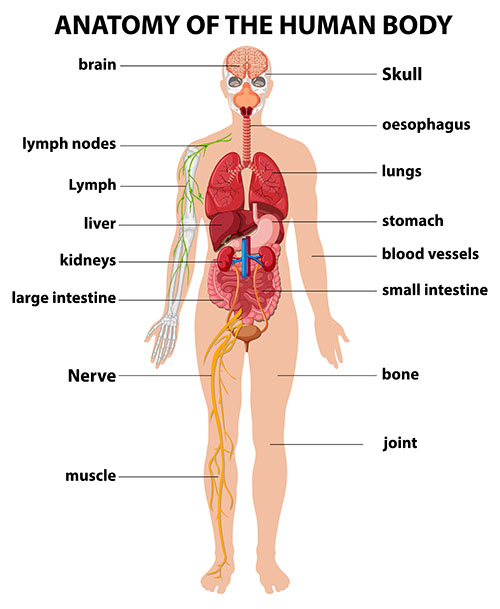


The human body is a masterpiece of evolution – perfectly designed to enable, sustain, and adapt to life. Although modern science has made enormous progress, there are still many processes in the body that are not fully understood. In this article, we will take a look at two different perspectives: Western medicine and Traditional Chinese Medicine (TCM). Both approaches offer valuable insights into the structure and functions of the body.
A. Western Medicine:
The Body as a Machine
Western medicine often views the human body as a kind of biological machine made up of various systems working together to sustain life. This perspective is based on anatomy (the structure) and physiology (the functions).
Anatomy:
The Structure of the Body
The human body consists of several levels:
• Cells : The smallest building blocks of life. Each cell has specific functions, such as nerve cells transmitting signals or muscle cells enabling movement.
• Tissues : Groups of similar cells form tissues, such as muscle tissue, nerve tissue, or connective tissue.
• Organs : Different tissues work together to form organs, such as the heart, lungs, or liver.
• Systems : Organs form systems that perform specific functions, such as the cardiovascular system, respiratory system, or digestive system.
Physiology:
The Functions of the Body
Western medicine examines how these systems function and interact with each other.
For example:
• The heart pumps blood through the body, transporting oxygen and nutrients.
• The lungs exchange oxygen for carbon dioxide.
• The kidneys filter the blood and remove waste products.
Unknown Mechanisms
Despite all advances, there are still many unsolved mysteries. One example is the immune system: Why does it sometimes attack the body's own cells (autoimmune diseases)? Another example is the brain: How do consciousness and thoughts arise?
These questions continue to occupy scientists today.
Reserves and Capacities
The human body is extraordinarily resilient. Many organs have reserves that allow them to continue functioning even when damaged:
• Liver : Up to two-thirds of the liver can be damaged before serious problems occur.
• Kidney : You can live with just one kidney.
• Lung : One lung is sufficient to supply the body with oxygen.
However, there are also critical areas, such as the brain and the heart.
A small injury in the brain (e.g., due to a stroke) can have massive effects, such as speech disorders or paralysis. Similarly, even minor damage to the heart can be life-threatening.
B. Traditional Chinese Medicine:
The Body as Part of the Universe
TCM views the human body holistically and in close connection with nature and the universe. Instead of isolating individual organs or systems, it sees the body as a network of energies that must be kept in balance.
The Concept of Qi
In TCM, the flow of "Qi" (pronounced "Chee") is central. Qi is the life energy that flows through the body. If this flow is disrupted, diseases arise. TCM uses methods such as acupuncture, herbal medicine, and Tai Chi to restore the flow of Qi.
The Five Elements
TCM categorizes the body according to the five elements: Fire, Earth, Metal, Water, and Wood. Each element corresponds to specific organs and emotions:
• Fire : Heart and circulatory system, associated with joy.
• Earth : Spleen and stomach, associated with worry.
• Metal : Lungs and large intestine, associated with grief.
• Water : Kidneys and bladder, associated with fear.
• Wood : Liver and gallbladder, associated with anger.
Meridians and Energy Pathways
Unlike Western medicine, which focuses on nerves and blood vessels as the main pathways, TCM sees the body as a network of meridians (energy pathways). These pathways connect the organs and allow the flow of Qi.
Prevention Over Cure
A central aspect of TCM is prevention.
Instead of waiting for symptoms to appear, the focus is on keeping the body in balance. This is achieved through a healthy diet, meditation, and exercise.
Comparison of the Two Perspectives
Western medicine and TCM differ significantly in their approaches:
• Western Medicine : Analytical, focused on individual parts of the body, based on scientific studies.
• TCM : Holistic, focused on balance and the connection between body, mind, soul, and the environment.
Both approaches have their strengths and weaknesses. While Western medicine excels in acute illnesses and surgical interventions, TCM offers solutions for all and for chronic conditions and stress to.
Fascination and Unknowns of the Body
The human body is a true marvel. Despite all advances, there are still phenomena that science cannot fully explain. One example is liver regeneration: How does this organ manage to repair itself? Another mystery is the brain: How do feelings, thoughts, and consciousness arise?
The reserves and capacities of the body demonstrate its incredible adaptability. But they also have their limits. While we can live with only one kidney or one lung, other organs like the heart and brain are extremely sensitive. Even minor damage here can have catastrophic consequences.
Conclusion
The human body is a complex and perfectly coordinated system that can be admired from both Western and Eastern perspectives. Western medicine provides detailed insights into the functioning of individual organs and systems, while TCM views the body as part of a larger whole. Both approaches complement each other and help us better understand the wonder of the human body.
